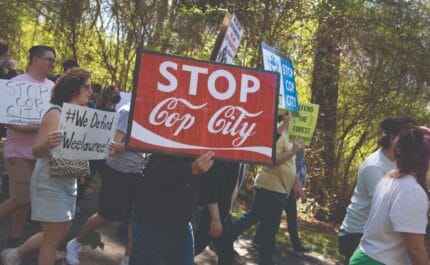Waste not, want not
The world is coming around to the circular economy. Between 2016 and 2020 the European Investment Bank, the lending arm of the European Union, provided €2.7 billion to co-finance circular economy projects and in June it was announced that the European Commission and the United Nations would collaborate to foster the movement globally. But in a world where two thirds of the raw materials that are turned into products end up as waste, can industry and consumer habits really undergo a drastic change? Photojournalist Luca Locatelli has spent the past three years visiting innovative projects that are leading the way

AeroFarms has transformed an abandoned steel mill warehouse in Newark into a vertical farm. Photo: Luca Locatelli/Institute
4th June 2021 (Taken from: #43)
“The linear economy is based on producing more than you will ever sell,” says Italian photojournalist Luca Locatelli. “It’s like inviting friends for dinner. You don’t want them to be unhappy, so you cook three more plates of pasta than you need. At the end of the night, it’s just going into the trash. The whole linear economy is based on this rationale – we produce more just in case and then simply throw the excess away.” When it comes to waste, we are certainly excessive: the UN estimates that the world produces 11.2 billion tonnes of solid waste a year. Many see an urgent need to break this cycle. “The circular economy is applying a system where waste is considered a resource,” says Locatelli, who has been documenting practitioners for three years. “In history we tried not to waste anything – we need to get that back”.
Denmark’s burning ambition

Billed as one of the cleanest waste-to-energy plants in the world, Amager Bakke in Copenhagen provides hot water to 120,000 households. Photo: Luca Locatelli/Institute
Locatelli’s exploration of the circular economy has taken him from a tyre recycling plant in the Netherlands to Icelandic lava fields, but when asked to pick some of the most memorable examples from the project, he starts with a contentious one.
Amager Bakke is a waste-to-energy incinerator in Copenhagen designed by architect Bjarke Ingels. It claims to be the world’s cleanest incinerator and provides hot water and electricity to 120,000 households. “Many people would say an incinerator cannot be part of a circular- economy system because it’s the end of the line. You are burning trash,” says Locatelli. “I chose to include it because it is a powerful industrial icon of our time. Unlike a lot of waste facilities, it is not hidden away: the Queen of Denmark can see it from her window and it has an artificial ski slope, the tallest climbing wall in the world and an educational centre dedicated to climate change.”
It is also an extremely powerful incinerator, burning through 70 tonnes of waste every hour. “It’s completely nuts,” says Locatelli. “According to those who run it, the filtration system means it’s not releasing any polluted air into the atmosphere.” The plant uses a series of advanced filters to remove particles and pollutants from the smoke and a process called ‘selective catalytic reduction’, which breaks down harmful nitrogen oxides into nitrogen and water vapour.
In fact, the main problem is that there’s not enough rubbish to feed it. Recycling-conscious Danes are no longer producing sufficient waste to keep the fires at Amager Bakke burning, so trash is being imported from the UK and Germany. Should that supply run out, the incinerator is also designed to work with biomass – although Locatelli believes such a switch may be a long time coming. “Of course, I would like to have a world without trash,” he says. “But we need to transition; we cannot be utopian any more. We need to deal with reality.”
New Jersey’s growing economy
AeroFarms in Newark is a vertical-farming company housed in a repurposed steel mill in one of New Jersey’s busiest industrial areas. The company aims to grow fresh vegetables sustainably right in the heart of cities. “AeroFarms is considered a champion in the circular economy, because one of the biggest problems we have is how to repurpose buildings,” says Locatelli. “This area in New Jersey is full of abandoned buildings from the first industrial revolution. This project generates life inside these places, which would have just been left to rot, or torn down – using more energy and creating more waste.”
AeroFarms’ produce – which includes kale, bok choy and watercress – is grown on a specially developed cloth made entirely from recycled plastic bottles. The system uses 95 percent less water than farming in fields and no pesticides are deployed, while soil monitoring allows for fertilisers to be used only where needed. The lighting is designed to minimise waste as well – the farm uses special LEDs which emit only those parts of the light spectrum needed by plants, to avoid wasting energy. “It’s a much more effective way of thinking about the mass production of food for cities,” says Locatelli. “Transportation of food [from rural to urban areas] is a big problem and this reduces that, all from inside disused buildings. I would love to see something like this in Milan, New York or London. They could even have markets where you can buy the produce. I mean, it makes sense.”
Magic mushrooms in Newark

Ecovative Design researchers Hazel Robertson and Jenifer Morgan-Davie check the growth status of fungus-based materials test samples in the biomaterials company’s headquarters in Green Island, New York. Photo: Photo: Luca Locatelli/Institute
A few hours up the Hudson River from AeroFarms’ green growers is Ecovative Design, a biomaterials company headquartered in Green Island, New York. Researchers there are investigating the potential of combining fungus with agricultural waste to provide sustainable alternatives to plastics and polystyrene foams. “They have come a long way in creating packaging from mushrooms,” says Locatelli. “Packaging is a huge problem. Every time Amazon rings the bell you think, ‘Oh god, I did it again’: opening a huge box and wading through paper and plastic just to get to the product, which is in its own packaging. What Ecovative are working on will hopefully mean all their used packaging will become nutrients for plants when it biodegrades.”

A 3D scanner is used to study a fungus structure. Photo: Luca Locatelli/Institute
But packaging isn’t the only area in which fungus may play a role. Locatelli is particularly excited about its potential for revolutionising building materials. Ecovative Design have created a system that combines fungi with agricultural waste products such as cotton hulls to create a new durable biomaterial. “The fungus binds the mixture,” says Locatelli. “For construction the potential is huge. Fungus can grow into every single space where there is air, and the researchers can kill the fungus as soon as it has filled the space. What you are left with is something which is strong and sturdy but totally organic.”
Italy’s fabric savers

Workers sort textiles by colour in Prato, Italy. Some warehouses hold materials in colours that have been out of fashion for more than 40 years, waiting for the market to want them again. Photo: Luca Locatelli/Institute
After the oil industry, clothes manufacturing is the largest polluter on the planet. According to the UN, the industry produces up to eight percent of global carbon emissions. And we barely even wear the clothes: according to a study by the charity Barnardo’s, the average garment is worn just seven times. “I spent time in textile-sorting companies and it’s crazy how many clothes are discarded as trash with the labels still on them,” says Locatelli. “Jeans are thrown away with the price tag on in the US. They go to India, where they will be sorted and then sent back to the US to be sold again as new. That’s the best-case scenario; so much that doesn’t get sorted ends up in landfill or burnt.”
In Prato, Italy, they’ve been doing things differently for generations. With wool in short supply after World War II, the textile companies here found a novel solution. They developed a process to make wool out of waste. “At the beginning they were dismantling used tennis balls to make clothes out of,” says Locatelli with a laugh.
Today mountains of discarded clothes, fabric and textiles are collected and sorted into specific colours. The fashion industry is notorious for working in cycles, so Prato’s manufacturers wait for a precise colour to come back into vogue, at which point clothes in the newly re-trendy hue are broken down to create an extremely fine wool which is provided to clothes companies. “For many years, especially in the ’90s when the high-end fashion companies were booming, they hid this fact from the world,” says Locatelli. “People might not be so keen to pay so much for something that is made out of trash.”
It seems the world is now coming around to Prato’s way of thinking and the Tuscan town has been lauded by the Italian government as a beacon of sustainability. “In Prato I was photographing plausible solutions for the future, but it was more like looking into the past,” says Locatelli. “The colours are still sorted by hand. They have tried to develop robots to separate out the different shades of colours, but nothing can beat the human eye. The people sitting on the floor that I photographed are highly specialised; nobody can create as precise a colour match. Not all solutions have to be about technology.”
Montana’s waterfront

Kevin McGraw (left), co-founder of Clearas, checks the company’s pilot test plant in Missoula with his colleague Jay Goldberg. Photo: Luca Locatelli/Institute
Based in Missoula, Montana, Clearas runs water-recovery bioreactors which use algae to recover phosphorus, nitrogen and other constituents from sewage water, making it safe to re-enter public waterways. “The experiments they have conducted have shown that the water coming out from the purification via algae was of better quality than that from the process we use nowadays in most other sewage systems,” says Locatelli. The process also creates byproducts that can be used to make everything from inks to tyres and from fuels to fertilisers. The company recently signed a contract with a partner that supplies algae-blended materials to the footwear industry, meaning it could be possible for Earth-friendly trainers to be produced from biomaterial used to clean wastewater.
“The company is in Montana – this is Trump country – and I was interested in how an environmentalist can make a living here,” says Locatelli. “[I was there before the 2020 election] and the co-founder of the company, Kevin McGraw, an incredibly generous guy, told me he was voting for Trump. It was eye-opening to me as I had this set idea of what an environmentalist looks like. Meanwhile one of the guys at Clearas proudly showed me a picture of himself shooting a grizzly bear in Alaska. I was shocked – but in a way it gave me hope. If you see someone who killed a grizzly creating the bioplastic for shoes, of course it’s disorientating, but they are still making a difference.
One thing I learned over the project is that you cannot ignore the business side of the circular economy. The fact is that some firms are making a lot of money in a virgin sector. It is possible for something to be the right thing to do for the planet as well as being profitable. Business is business, and getting traditional ‘bad guys’ such oil producers and plastic companies into the circular economy is a good sign for the transition.”
Slow Journalism in your inbox, plus infographics, offers and more: sign up for the free DG newsletter. Sign me up
Thanks for signing up.








